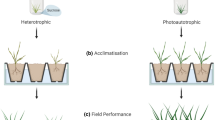Summary
Photoautotrophic (sugar-free) micropropagation has been examined for many different plant species. One of the advantages of photoautotrophic micropropagation is the low risk of contamination, which facilitates the use of large culture vessels, and thus contributes to the reduction in production cost. In this article, pathogenic and nonpathogenic contaminations are discussed, and guidelines for development of large-scale, pathogen-free, photautotrophic micropropagation systems are introduced. A preliminary experiment was conducted for producing pathogen-free plantlets by large-scale photoautotrophic micropropagation. Addition of AgNO3 in the medium was shown to suppress growth of nonpathogenic contaminants without reducing fresh and dry weight, and number of leaves of the tomato plantlets.
Similar content being viewed by others
References
Aino, M.; Maekawa, Y.; Mayama, S.; Kato, H. Biocontrol of bacterial wilt of tomato by producing seedlings colonized with endophytic antagonistic pseudomonads. Proceedings of the 5th International Workshop on Plant Growth-Promoting Rhizobacteria, Sapporo, Japan; 1997:120–123.
Cassells, A. C. Problems in tissue culture: culture contamination. In: Debergh, P. C.; Zimmerman, R. H., ed. Micropropagation. Dordrecht, The Netherlands: Kluwer Academic Publishers; 1991:31–44.
Kyriakides, A. L.; Patel, P. D. Luminescence techniques for microbiological analysis of foods. In: Patel, P. D., ed. Rapid analysis techniques in food microbiology. London: Blackie Academic & Professional; 1994:196–231.
Kozai, T.; Fujiwara, K.; Hayashi, M.; Aitken-Christie, J. The in-vitro environment and its control in micropropagation. In: Kurata, K.; Kozai, T., ed. Transplant production systems. Dordrecht, The Netherlands: Kluwer Academic Publishers; 1992:247–282.
Kozai, T.; Smith, M. A. L. Environmental control in plant tissue culture: general introduction and overview. In: Aitken-Christie, J.; Kozai, T.; Smith, M. A. L., ed. Automation and environmental control in plant tissue culture. Dordrecht, The Netherlands: Kluwer Academic Publishers; 1995:301–318.
Murashige, T.; Skoog, F. A revised medium for rapid growth and bioassays with tobacco tissue cultures. Physiol. Plant. 15:473–497; 1962.
Roche, T. D.; Long, R. D.; Sayegh, A. J.; Hennerty, M. J. Commercial-scale photoautotrophic micropropagation: applications in Irish agriculture, horticulture and forestry. Acta Hortic. 440:515–520; 1997.
Yanagawa, T.; Nagai, M.; Ogino, T.; Maeguchi, R. Application of disinfectants to orchid seeds, plantlets and media as a means to prevent in vitro contamination. Lindleyana 10:33–36; 1995.
Author information
Authors and Affiliations
Rights and permissions
About this article
Cite this article
Kubota, C., Tadokoro, N. Control of microbial contamination for large-scale photoautotrophic micropropagation. In Vitro Cell.Dev.Biol.-Plant 35, 296–298 (1999). https://doi.org/10.1007/s11627-999-0037-6
Received:
Accepted:
Issue Date:
DOI: https://doi.org/10.1007/s11627-999-0037-6




